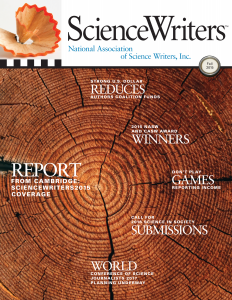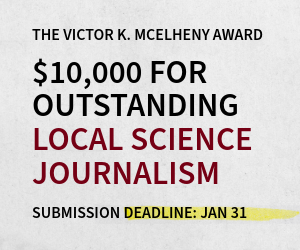By James Cornell, ISWA President (retired)
The International Science Writers Association (ISWA), arguably the world’s oldest international organization of science journalists, has a new roster of officers as of Sept. 1. Yours truly has retired from the office of president and was succeeded by Pallava Bagla, author, columnist, Science correspondent, and science editor for New Delhi Television, India.
Other new officers include: Vice President Lucy Calderon, freelance science reporter based in Guatemala City, Guatemala; Treasurer Larry Krumenaker, author, educator, editor of The Classroom Astronomer, and an NASW member currently residing in Germany after a stint at the Heidelberg Institute of Theoretical Studies; Secretary/Webmaster Sedeer el-Showk, freelance science writer and biologist based in Rabat, Morocco; and member-at-large Wolfgang Goede, freelance journalist and former science editor of Germany’s PM Magazine, who divides his time between Munich and Colombia. I will continue to serve as senior consultant from Tucson, Ariz., which some consider a foreign country.Founded in 1967, ISWA has always played a unique role in international journalism by providing a loose global network of mutual support for independent writers and communicators, especially those who have no national or regional groups with whom to affiliate. Indeed, for more than a decade, ISWA has represented such individuals in the World Federation of Science Journalists (WFSJ).
For the foreseeable future, the purpose of ISWA remains to foster person-to-person contacts between individual journalists. Also unchanged is the current membership fee of $25; deliberately kept low to accommodate members from the developing world.
The new leadership has expanded communications and outreach efforts with the addition of a LinkedIn and Facebook presence. These join the ISWA website [internationalsciencewriters.org(http://internationalsciencewriters.org) and members-only newsletter (edited by Krumenaker).
The history of ISWA
The concept of what would eventually become the International Science Writers Association was first discussed in the early 1960s by a group of globetrotting science journalists who convened regularly in Houston to cover the U.S. space program.
First formal step toward creating a global club to help writers lost and linguistically challenged in strange lands took place in 1966, when a group of senior science writers and editors met in London to talk about the benefits of a mutual-support network. Among them was Gordon Rattray Taylor of the BBC, John Maddox of Nature, and Dennis Flanagan of Scientific American.
The following year, at the World’s Fair in Montréal (EXPO 67), the trio joined forces with several North American writers (and NASW members) including Robert Cowen of the Christian Science Monitor, Howard Lewis of the U.S. National Academy of Sciences, and Fred Poland of the Montréal Star. They wrote and approved a draft constitution and elected officers with Maddox serving as president. They also dismissed a motion to create a “federation of associations” in favor of what ISWA would become and remains today: an organization of individual membership.
For the next 30 years, ISWA provided its international membership with connections to the wider world of science communication. Initially serving a largely Anglo-American-Canadian cadre of expatriate journalists (among its ranks Sir Arthur C. Clarke of Sri Lanka), ISWA began in the 1980s to actively seek out journalists from emerging nations in a determined effort to literally change the organization’s complexion. ISWA would grow to more than 400 members in some 40 nations.
Eventually, ISWA become a facilitator of training and education programs around the world, as well as the publisher of a newsletter providing information about fellowships, jobs, and other professional opportunities. Many NASW members first became aware of ISWA through its mentoring of young German reporters at the AAAS annual meetings and a reciprocal program for U.S. reporters at the biennial ESOF meetings in Europe. Both efforts funded by the Bosch Foundation.
Today, most of ISWA’s former services can be provided more efficiently and on a much larger scale by nonprofit organizations, such as SciDev.Net. Furthermore, science journalism has matured into a distinct and respected discipline worldwide, with national associations flourishing in those same countries and regions where once a single science journalist might have struggled to survive.
Although ISWA is now a much smaller organization (some 50 members in two dozen countries), it still continues to play two vital roles.
First, in those countries without national associations, individual journalists can join ISWA and have their interests represented within the WFSJ.
The second role is a bit less tangible if no less important: ISWA provides direct person-to-person connections in a world increasingly dehumanized by electronic, computerized, and digital communications. ISWA members are still individuals with direct links to a specific place who can offer personal advice and counsel about a country’s top plant geneticist, or a city’s best restaurant.
(NASW members can read the rest of the Fall 2015 ScienceWriters by logging into the members area.) Free sample issue. How to join NASW.




